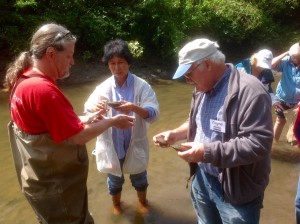Volunteers complete training, graduate as master naturalists
Chronicle Media — October 29, 2015
Dr. Felicitas Sebastian (center) was one of 20 volunteers in October who completed in-depth field training with the University of Illinois Extension to become members of the Illinois Grand Prairie Chapter of Master Naturalists. (Photo courtesy U of I Extension)
The University of Illinois Extension-Livingston, McLean, and Woodford Counties graduated 20 new volunteers to the Illinois Grand Prairie Chapter of Master Naturalists on Oct. 16.
This year’s training included nearby sites of discovery (a mammoth tusk and tooth in Lincoln), restoration (native prairie in Kempton), indigenous peoples (Dickson Mounds and the surrounding bluffs—just before the museum closed at the end of last month), agriculture and wildlife (hosted by PrairiErth farm near Atlanta), and more.
For one Master Naturalist trainee, it was studying the flowing waterways of central Illinois that provided an unexpected memory of her childhood. “Dr. Felicitas Sebastian, who spent her career as a clinical psychologist, has been a hands-on learner this fall,” said Reid Young, University of Illinois Extension program coordinator for the local master naturalists. “She is always up front and engages hands-on whenever she can.”
In September, the class was wading in the South Fork of the Vermillion River, just north of Fairbury with Kevin Cummings of the Illinois Natural History Survey. While looking for mussels and clams, a small purplish shell caught Sebastian’s attention. She remembers thinking in disbelief “how did you get here?” Cummings identified it as an “exotic Asian clam.”
What Sebastian recognized was the shell of a mussel called “tulya,” an ingredient in soups her mother made for her as a child in the Philippines. The mussel was also recommended to new mothers to help with production of breast milk.
Tulya’s common name in the U.S. is simply “Asian clam” (scientific name Corbicula fluminea); however, it is native to every continent but the Americas and Antarctica. It showed up in Washington State in 1938, where scientists believe it was being imported as a food source. Its prevalence in the Midwest began in the early 1960s.
Sebastian has been able to share the story and a photo of the shell with her family in the Philippines via video chat. Her mother “could not contain her amazement and laughter when I told her the story.” Her siblings asked where she found it. Feli jokes that the clams are “just like Filipinos—we are found all over the world!”
Master Naturalist training is a series of science-based trainings to connect people with the natural areas that surround them, and help them become engaged environmental stewards.
— Volunteers complete training, graduate as master naturalists —



